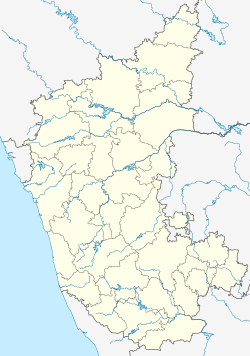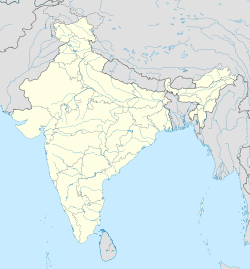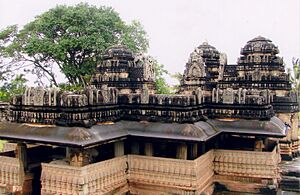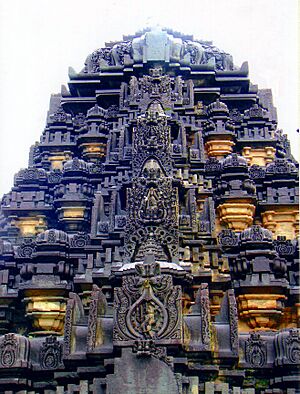Balligavi facts for kids
Quick facts for kids
Balligavi
|
|
|---|---|
|
town
|
|
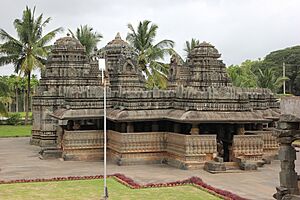
Kedareshvara temple at Balligavi
|
|
| Country | |
| State | Karnataka |
| District | Shivamogga District |
| Languages | |
| • Official | Kannada |
| Time zone | UTC+5:30 (IST) |
Balligavi is a historic town in the Shivamogga district of Karnataka state, India. Today, it is also known as Belagami or Balagame. In ancient times, it had names like Baligrama and Dakshina Kedara. Dakshina Kedara means "Kedarnath of the South," showing its importance.
This old town is famous for its many ancient monuments and temples. Balligavi is about 72 kilometers from Shivamogga city. The word Balli in Kannada language means a creeper or vine.
Archaeologists believe Balligavi dates back to the time of the Satavahana and Kadamba kingdoms. A special four-faced linga (a symbol of the Hindu god Shiva) found here is from that period. The area was part of the Kadamba Dynasty's Banavasi province around the 4th and 5th centuries AD. Important writings from the Kadamba period, like the Talagunda inscriptions, have been found near Balligavi.
Contents
A Golden Age
Balligavi truly shined during the rule of the Western Chalukya Empire from the 10th to 12th centuries. The oldest writing mentioning Balligavi is from 685 CE, during the Badami Chalukya period.
During its golden age, Balligavi was a very busy place. It had six mathas (centers for religious learning and worship). It also had five vidyapithas (places of learning, like universities) and seven Brahmapuris (settlements for scholars). These mathas belonged to different religions, including Shaivism (worship of Shiva), Vaishnavism (worship of Vishnu), Jainism, and Buddhism.
The Kedareshwara matha and the Kodiya matha were especially famous. Even the Hoysala emperors supported them. This shows that Balligavi was a major center for religious activities. Records also tell us that an ancient university once existed here. The town had 54 temples and was home to 60,000 people during that time! Many old inscriptions show that it was a strong base for the Vira Bananju warrior merchant community.
Today, Balligavi is a quiet town. Its daily life mostly revolves around farming and its famous 11th-century temples, the Kedaresvara Temple and the Tripurantakesvara Temple.
An Old Legend
There's a legend that says Balligavi was once the capital of an Asura (demon) king. Because of this, it was called Balipura, meaning "city of Bali".
The Pandavas, famous heroes from the ancient Indian epic Mahabharata, are said to have visited Balligavi. They came here during their Vanavasa (a time when they lived in the forest). They installed five lingas (symbols of Shiva) here. That's why the well-known temple in Balligavi is called Panchalingeswara, meaning "five lingas of Shiva."
Famous People from Balligavi
Balligavi is also the birthplace of some very important historical figures.
One such person is the great Virashaiva saint Allama Prabhu. The town is also closely connected to the famous poet Akka Mahadevi. She was born in nearby Udugani and was a contemporary of Allama Prabhu and Basavanna, who founded the Virashaiva movement.
Another notable person from Balligavi is Shantala Devi. She was the queen of the Hoysala king Vishnuvardhana. Many famous Hoysala sculptors, like Dasoja and Malloja, also came from this historic town.
Kedaresvara Temple
The Kedaresvara Temple is a wonderful example of temple architecture. It has three towers, which is called a trikuta style. Its design mixes elements from both the Western Chalukya and Hoysala styles. It is believed to be the oldest example of this combined style in Karnataka.
The temple faces east and has stepped entrances on three sides. The central shrine has a linga (symbol of Shiva) made from black marble. The shrine to the south has a linga called Brahma. The shrine to the north has a statue of Janardhana (a form of Vishnu).
The outside walls of the temple are designed in a "staggered-square" style. This means they have many parts that stick out and go in, which is a typical Hoysala design. The outer walls of the open mandapa (hall) have beautiful carvings of women wearing fine jewelry. Two Hoysala emblems were added to the temple in 1060 CE.
The towers (called vimana) are very well decorated with sculptures of gods like Tandaveshwara (dancing Shiva) and Varaha (a form of Vishnu). The western shrine is the oldest part, dating back to the 7th or 8th century.
Inside, there is a well-designed open mantapa (hall) with two rows of pillars. The outer pillars have 16 sides. The inner pillars are smooth and bell-shaped, a style popular with both the Western Chalukyas and Hoysalas. The ceiling of the mantapa is flat. The inner ceiling has beautiful carvings of lotus flowers. The central ceiling shows Tandaveshwara (dancing Shiva) surrounded by eight dikpalakas (guardian gods). At the entrance to the main shrine, you can see a statue of Nandi, the bull, who is Shiva's loyal companion.
Tripurantaka Temple
The Tripurantaka Temple was built around 1070 CE by the Western Chalukyas. This temple is now in a damaged state, but it is still an important part of Balligavi's history.
The outside walls of the temple have small sculptures on friezes (decorative bands). These carvings are quite rare in Chalukyan art. They are very small, so you need to look closely to see them.
During medieval times, Balligavi was a major center for learning and different religions. It had many monuments and buildings created by the Chalukyas. More than 80 old epigraphy (inscriptions or writings carved into stone) have been found in Balligavi. These inscriptions belong to Hindu (Shaiva, Vaishnava), Jain, and Buddhist traditions. They tell us many things, including how these temples were built.


